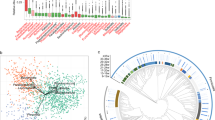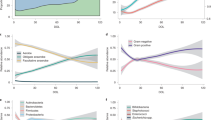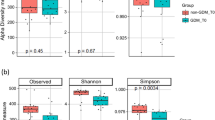Abstract
Background
The biological mechanism by which the maternal gastrointestinal microbiota contributes to fetal growth and neonatal birth weight is currently unknown. The purpose of this study was to explore how the composition of the maternal microbiome in varying pre-gravid body mass index (BMI) groups are associated with neonatal birth weight adjusted for gestational age.
Methods
Retrospective, cross-sectional metagenomic analysis of bio-banked fecal swab biospecimens (n = 102) self-collected by participants in the late second trimester of pregnancy.
Results
Through high-dimensional regression analysis using principal components (PC) of the microbiome, we found that the best performing multivariate model explained 22.9% of the variation in neonatal weight adjusted for gestational age. Pre-gravid BMI (p = 0.05), PC3 (p = 0.03), and the interaction of the maternal microbiome with maternal blood glucose on the glucose challenge test (p = 0.01) were significant predictors of neonatal birth weight after adjusting for potential confounders including maternal antibiotic use during gestation and total gestational weight gain.
Conclusions
Our results indicate a significant association between the maternal gastrointestinal microbiome in the late second trimester and neonatal birth weight adjusted for gestational age. Moderated by blood glucose at the time of the universal glucose screening, the gastrointestinal microbiome may have a role in the regulation of fetal growth.
Impact
-
Maternal blood glucose in the late second trimester significantly moderates the relationship between the maternal gastrointestinal microbiome and neonatal size adjusted for gestational age.
-
Our findings provide preliminary evidence for fetal programming of neonatal birth weight through the maternal gastrointestinal microbiome during pregnancy.
This is a preview of subscription content, access via your institution
Access options
Subscribe to this journal
Receive 14 print issues and online access
$259.00 per year
only $18.50 per issue
Buy this article
- Purchase on Springer Link
- Instant access to full article PDF
Prices may be subject to local taxes which are calculated during checkout

Similar content being viewed by others
Data availability
The raw sequencing reads used in this study are publically available through the National Center for Biotechnology Information (NCBI) under the accession identifier PRJNA862188. The clinical metadata are available upon reasonable request from the Obstetric and Neonatal Outcomes Study (ONOS) research team at the University of Virginia Health System.
References
Rinaudo, P. & Wang, E. Fetal programming and metabolic syndrome. Annu. Rev. Physiol. 74, 107–130 (2012).
Kwon, E. J. & Kim, Y. J. What is fetal programming?: a lifetime health is under the control of in utero health. Obstet. Gynecol. Sci. 60, 506–519 (2017).
Hullar, M. A. J. & Fu, B. C. Diet, the gut microbiome, and epigenetics. Cancer J. 20, 170–175 (2014).
Wright, M. L. & Starkweather, A. R. Antenatal microbiome: potential contributor to fetal programming and establishment of the microbiome in offspring. Nurs. Res. 64, 306–319 (2015).
Canani, R. B. et al. Potential beneficial effects of butyrate in intestinal and extraintestinal diseases. World J. Gastroenterol. 17, 1519–1528 (2011).
Wilson, R. M. & Messaoudi, I. The impact of maternal obesity during pregnancy on offspring immunity. Mol. Cell. Endocrinol. 418, 134–142 (2015).
Van Lieshout, R. J., Taylor, V. H. & Boyle, M. H. Pre-pregnancy and pregnancy obesity and neurodevelopmental outcomes in offspring: a systematic review. Obes. Rev. 12, e548–e559 (2011).
Patel, S. P. et al. Associations between pre-pregnancy obesity and asthma symptoms in adolescents. J. Epidemiol. Community Health 66, 809–814 (2012).
Monasta, L. et al. Early-life determinants of overweight and obesity: a review of systematic reviews. Obes. Rev. 11, 695–708 (2010).
Ruager-Martin, R., Hyde, M. J. & Modi, N. Maternal obesity and infant outcomes. Early Hum. Dev. 86, 715–722 (2010).
Khandaker, G. M., Dibben, C. R. M. & Jones, P. B. Does maternal body mass index during pregnancy influence risk of schizophrenia in the adult offspring. Obes. Rev. 13, 518–527 (2012).
Kelsey, C. M. et al. Gut microbiota composition is associated with newborn functional brain connectivity and behavioral temperament. Brain Behav. Immun. 91, 472–486 (2021).
Kozyrskyj, A. L., Kalu, R., Koleva, P. T. & Bridgman, S. L. Fetal programming of overweight through the microbiome: boys are disproportionately affected. J. Dev. Orig. Health Dis. 7, 25–34 (2016).
Dreisbach, C., Prescott, S. & Alhusen, J. Influence of maternal prepregnancy obesity and excessive gestational weight gain on maternal and child gastrointestinal microbiome composition: a systematic review. Biol. Res. Nurs. 22, 114–125 (2020).
Dreisbach, C. et al. Metabolic and microbial changes associated with diet and obesity during pregnancy: what can we learn from animal studies. Front. Cell. Infect. Microbiol. 11, 795924 (2021).
White, R. A. et al. Novel developmental analyses identify longitudinal patterns of early gut microbiota that affect infant growth. PLoS Comput. Biol. 9, e1003042 (2013).
Bervoets, L. et al. Differences in gut microbiota composition between obese and lean children: a cross-sectional study. Gut Pathog. 5, 10 (2013).
Ignacio, A. et al. Correlation between body mass index and faecal microbiota from children. Clin. Microbiol. Infect. 22, 258.e1–8 (2016).
O’Callaghan, A. & van Sinderen, D. Bifidobacteria and their role as members of the human gut microbiota. Front. Microbiol. 7, 925 (2016).
Catalano, P. M., Huston, L., Amini, S. B. & Kalhan, S. C. Longitudinal changes in glucose metabolism during pregnancy in obese women with normal glucose tolerance and gestational diabetes mellitus. Am. J. Obstet. Gynecol. 180, 903–916 (1999).
Wang, Y. et al. Association among pre-pregnancy body mass index, gestational weight gain and neonatal birth weight: a prospective cohort study in China. BMC Pregnancy Childbirth 20, 690 (2020).
Gul, R. et al. Pre-pregnancy maternal BMI as predictor of neonatal birth weight. PLoS ONE 15, e0240748 (2020).
Wang, J. et al. Dysbiosis of maternal and neonatal microbiota associated with gestational diabetes mellitus. Gut 67, 1614–1625 (2018).
American College of Obstetricians and Gynocologists. ACOG Practice Bulletin No. 190: Gestational Diabetes Mellitus. Obstet. Gynecol. 131, e49–e64 (2018).
Dreisbach, C. et al. Association between microbial composition, diversity, and function of the maternal gastrointestinal microbiome with impaired glucose tolerance on the Glucose Tolerance Test. PLoS ONE 17, e0271261 (2022).
Rao, S. S., Disraeli, P. & McGregor, T. Impaired glucose tolerance and impaired fasting glucose. Am. Fam. Physician 69, 1961–1968 (2004).
Baran, J. et al. Relationship between children’s birth weight and birth length and a risk of overweight and obesity in 4-15-year-old children. Medicine 55, E487 (2019).
von Elm, E. et al. The Strengthening the Reporting of Observational Studies in Epidemiology (STROBE) statement: guidelines for reporting observational studies. J. Clin. Epidemiol. 61, 344–349 (2008).
Bolger, A. M., Lohse, M. & Usadel, B. Trimmomatic: a flexible trimmer for Illumina sequence data. Bioinformatics 30, 2114–2120 (2014).
Langmead, B. & Salzberg, S. L. Fast gapped-read alignment with Bowtie 2. Nat. Methods 9, 357–359 (2012).
Li, D., Liu, C. M., Luo, R., Sadakane, K. & Lam, T. W. MEGAHIT: an ultra-fast single-node solution for large and complex metagenomics assembly via succinct de Bruijn graph. Bioinformatics 31, 1674–1676 (2015).
Wood, D. & Salzberg, S. L. Kraken: ultrafast metagenomic sequence classification using exact alignments. Genome Biol. 15, R46 (2014).
McCulloch, J. A. Home · johnmcculloch/JAMS_BW Wiki. GitHub. https://github.com/johnmcculloch/JAMS_BW (2022).
Lima, R. J. C. P. et al. Prepregnancy body mass index, gestational weight gain, and birth weight in the BRISA cohort. Rev. Saude Publica 52, 46 (2018).
Rasmussen, K. M., Catalano, P. M. & Yaktine, A. L. New guidelines for weight gain during pregnancy: what obstetrician/gynecologists should know. Curr. Opin. Obstet. Gynecol. 21, 521–526 (2009).
Oken, E., Kleinman, K. P., Rich-Edwards, J. & Gillman, M. W. A nearly continuous measure of birth weight for gestational age using a United States national reference. BMC Pediatr. 3, 6 (2003).
Carasi, P. et al. Impact of kefir derived Lactobacillus kefiri on the mucosal immune response and gut microbiota. J. Immunol. Res. 2015, 361604 (2015).
Luck, H. et al. Gut-associated IgA+ immune cells regulate obesity-related insulin resistance. Nat. Commun. 10, 3650 (2019).
Ustinova, M. et al. Metformin strongly affects transcriptome of peripheral blood cells in healthy individuals. PLoS ONE 14, e0224835 (2019).
Belkaid, Y. & Hand, T. W. Role of the microbiota in immunity and inflammation. Cell 157, 121–141 (2014).
Martino, D. The effects of chlorinated drinking water on the assembly of the intestinal microbiome. Challenges 10, 10 (2019).
Bruno, A. et al. Changes in the drinking water microbiome: effects of water treatments along the flow of two drinking water treatment plants in a urbanized area, Milan (Italy). Front. Microbiol. 9, 2557 (2018).
Sun, J., Nwaru, B. I., Hua, J., Li, X. & Wu, Z. Infant BMI peak as a predictor of overweight and obesity at age 2 years in a Chinese community-based cohort. BMJ Open 7, e015122 (2017).
Zhang, J. et al. Birth weight, growth and feeding pattern in early infancy predict overweight/obesity status at two years of age: a birth cohort study of Chinese infants. PLoS ONE 8, e64542 (2013).
Qiao, Y. et al. Birth weight and childhood obesity: a 12-country study. Int. J. Obes. Suppl. 5, S74–S79 (2015).
Schellong, K., Schulz, S., Harder, T. & Plagemann, A. Birth weight and long-term overweight risk: systematic review and a meta-analysis including 643,902 persons from 66 studies and 26 countries globally. PLoS ONE 7, e47776 (2012).
Carbonero, F. Human epigenetics and microbiome: the potential for a revolution in both research areas by integrative studies. Future Sci. 3, FSO207 (2017).
Jarde, A. et al. Pregnancy outcomes in women taking probiotics or prebiotics: a systematic review and meta-analysis. BMC Pregnancy Childbirth 18, 14 (2018).
de Brito Alves, J. L. et al. Gut microbiota and probiotic intervention as a promising therapeutic for pregnant women with cardiometabolic disorders: present and future directions. Pharmacol. Res. 145, 104252 (2019).
Didari, T., Solki, S., Mozaffari, S., Nikfar, S. & Abdollahi, M. A systematic review of the safety of probiotics. Expert Opin. Drug Saf. 13, 227–239 (2014).
Dugoua, J. J. et al. Probiotic safety in pregnancy: a systematic review and meta-analysis of randomized controlled trials of Lactobacillus, Bifidobacterium, and Saccharomyces spp. J. Obstet. Gynaecol. Can. 31, 542–552 (2009).
Kuang, Y. S. et al. Connections between the human gut microbiome and gestational diabetes mellitus. Gigascience 6, 1–12 (2017).
Tierney, B. T. et al. The predictive power of the microbiome exceeds that of genome-wide association studies in the discrimination of complex human disease. Preprint at bioRxiv https://doi.org/10.1101/2019.12.31.891978 (2020).
UK Biobank. Learn more about UK Biobank. https://www.ukbiobank.ac.uk/learn-more-about-uk-biobank (2022).
National Institutes of Health. All of Us research program. https://allofus.nih.gov/future-health-begins-all-u (2020).
Bassis, C. M. et al. Comparison of stool versus rectal swab samples and storage conditions on bacterial community profiles. BMC Microbiol. 17, 78 (2017).
Acknowledgements
We would like to thank Briana Cortez Chronister and Wuxing Yuan for their contributions to this study. Further, we thank Research Computing at The University of Virginia for providing computational resources and technical support that have contributed to the results reported within this publication (URL: https://rc.virginia.edu).
Funding
This research was supported with funding from F31NR017821 (to C.D.), the Association for Women’s Health, Obstetric, and Neonatal Nurses 2018 March of Dimes Margaret Comerford Freda “Saving Babies, Together®” Award (to C.D.).
Author information
Authors and Affiliations
Contributions
C.D., A.M.S.-R., and J.A. designed and conceptualized the study; A.M.S.-R. and D.D. oversaw the data repository and parent study; S.P. and G.T. supported the sequencing of the biospecimens; C.D., J.M., and C.K. completed the data analysis with clinical data support from L.H. C.D. drafted the manuscript with all other authors providing substantive feedback and final approval.
Corresponding author
Ethics declarations
Competing interests
The authors declare no competing interests.
Ethics approval and consent to participate
Participants gave consent for use of their biospecimens and medical record data for the purposes of research in the Obstetric and Neonatal Outcomes Study. No new consent was required.
Additional information
Publisher’s note Springer Nature remains neutral with regard to jurisdictional claims in published maps and institutional affiliations.
Supplementary Information
Rights and permissions
Springer Nature or its licensor (e.g. a society or other partner) holds exclusive rights to this article under a publishing agreement with the author(s) or other rightsholder(s); author self-archiving of the accepted manuscript version of this article is solely governed by the terms of such publishing agreement and applicable law.
About this article
Cite this article
Dreisbach, C., Prescott, S., Siega-Riz, A.M. et al. Composition of the maternal gastrointestinal microbiome as a predictor of neonatal birth weight. Pediatr Res 94, 1158–1165 (2023). https://doi.org/10.1038/s41390-023-02584-4
Received:
Revised:
Accepted:
Published:
Issue Date:
DOI: https://doi.org/10.1038/s41390-023-02584-4



